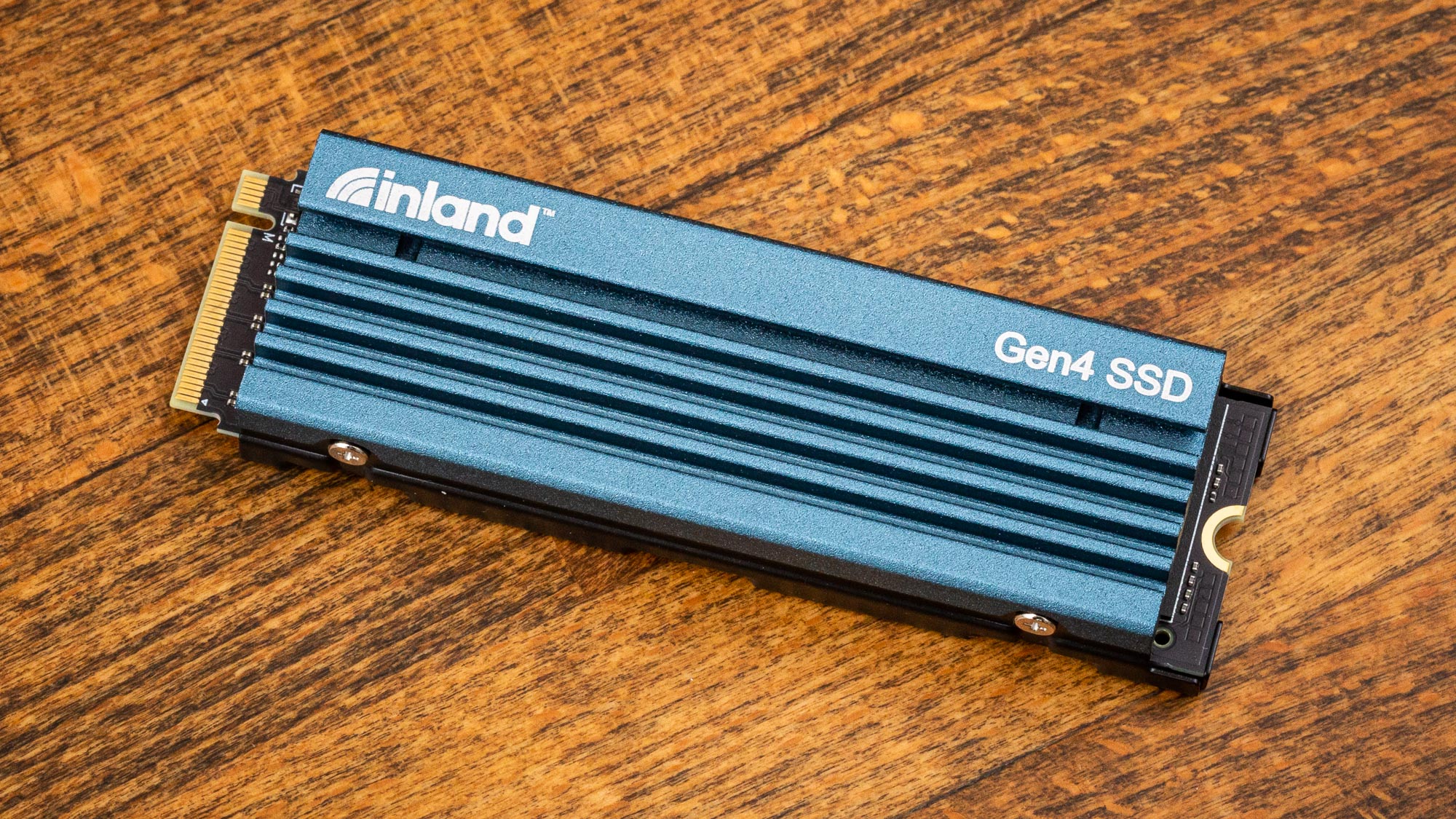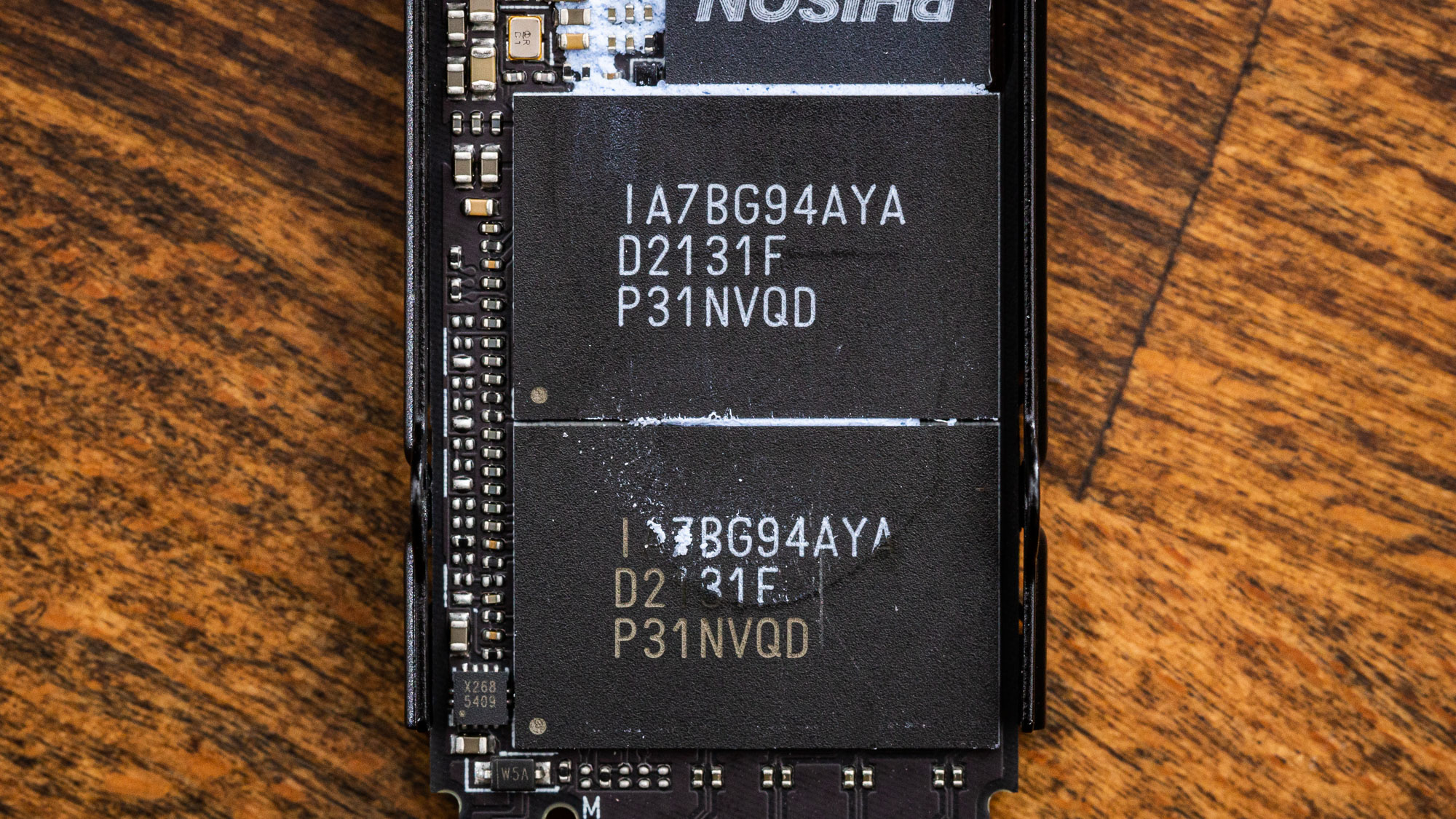Tom's Hardware Verdict
Although the Gaming Performance Plus 2TB does nothing new, it does deliver in every important department with good performance, simple looks, it runs cool and efficient, and it all comes with a six-year warranty and brick and mortar availability.
Pros
- +
+ Excellent performance
- +
+ Strong warranty period
- +
+ Convenience/availability
- +
+ PS5 compatibility
- +
+ Runs cool and efficient with an understated heatsink
- +
+ Balanced cache design
Cons
- -
No software
Why you can trust Tom's Hardware
The Inland Gaming Performance Plus is rated for up to 7.0 GBps of bandwidth, peaking at 700,000 IOPS over the PCIe 4.0 interface. This matches many other drives based on the Phison E18 SSD controller, including Inland’s regular Performance Plus that we reviewed previously. The new Gaming Performance Plus drive is ostensibly oriented at gaming and is specifically marketed as compatible with the Playstation 5 (PS5).
We also recently reviewed the Inland Prime, an entry-level drive with a surprisingly decent six-year warranty. In fact, the Inland Gaming Performance Plus is also supported for six years, which is a bit more than the typical five. Warrantied writes are nothing special at 700TBW per TB of capacity, though.
Inland is best known as Micro Center’s house brand for solid state drives (SSDs), offering convenience for builders lucky enough to live near one of the company's brick and mortar (B&M) locations. The availability of the drives is a big selling point, especially as returns can go through the store. While the Inland drives don't really offer anything special over other third-party manufacturers, the consistency of the lineup (segmented with different “P” models) means there’s a drive for everyone.
Any SSD will be a big improvement over a hard drive (HDD) when it loads a game, but beyond that, there’s usually not a huge difference between entry-level SATA and high-end PCIe SSDs. There's enough difference to attract enthusiasts, of course, but the real path lies ahead: DirectStorage will, in time, make NVMe drives a more exciting prospect for gaming PCs. In the meantime, drives like this are good for upgrading a PS5, although the difference between drives in that console is often not very pronounced as long as they work.
We, of course, have seen a lot of Phison E18-based drives, including with Micron’s new 176-layer TLC (B47R) flash, so there's nothing new o the hardware front here. The heatsink on the Gaming Performance Plus is a nice touch, but we’ll see if Inland has any other tricks up its sleeve.
Specifications
| Product | 1TB | 2TB |
|---|---|---|
| Pricing | $144.99 | $279.99 |
| Capacity (User / Raw) | 1000GB / 1024GB | 2000GB / 2048GB |
| Form Factor | M.2 2280 | M.2 2280 |
| Interface / Protocol | PCIe 4.0 x4 / NVMe 1.4 | PCIe 4.0 x4 / NVMe 1.4 |
| Controller | Phison E18 | Phison E18 |
| DRAM | DDR4 | DDR4 |
| Memory | Micron 176L TLC | Micron 176L TLC |
| Sequential Read | 7,000 MBps | 7,000 MBps |
| Sequential Write | 5,500 MBps | 6,850 MBps |
| Random Read | 350,000 IOPS | 650,000 IOPS |
| Random Write | 700,000 IOPS | 700,000 IOPS |
| Security | N/A | N/A |
| Endurance (TBW) | 700 TB | 1,400 TB |
| Part Number | 356113 | 356139 |
| Warranty | 6-Year | 6-Year |
The Gaming Performance Plus is rated for sequential speeds of up to 7.0/6.85 GBps read/write and up to 650,000/700,000 random read/write IOPS. Unfortunately, it’s available only at 1TB and 2TB. Current Micro Center (MC) pricing pegs it at around $0.14 per gigabyte, being a bit higher right now if purchased outside of an MC. This is a bit high compared to SSDs you'll find on sale and even some competing products - see our upcoming XS70 review - but is below the obnoxiously premium prices we sometimes see in this space. It’s difficult for a drive of this caliber to hit its stride at just 500/512GB, and 4TB drives with TLC are still expensive or difficult to get, so the omission of these capacities is not surprising.
The SSDs' IOPS are notably lower than other E18 drives, particularly models using 176-layer flash, but in practice, this is not super relevant for a consumer drive. Plus, those limitations may not be accurate, given that specifications for other Inland drives have been wrong in the past.
There’s nothing too exciting here, although one must appreciate that SSDs are now ubiquitous enough to allow premium models from a store brand.
Get Tom's Hardware's best news and in-depth reviews, straight to your inbox.
Software and Accessories
Inland drives are known for minimal fluff; there's not too much in the way of software. They tend to be based on Phison SSD controllers, and, therefore, it is sometimes possible to find universal or generic firmware updates. That being said, firmware updates should rarely be needed.
Other features, such as monitoring health, cloning, et cetera, can be managed with free software packages like CrystalDiskInfo (CDI) and Macrium Reflect Free. Inland may want to minimize its support structure, which makes sense, but there is an opportunity for the company to stand out in the future if it so desires.
A Closer Look





The Gaming Performance Plus comes in the typical M.2 2280 form factor with a significantly-thick, aqua-colored heatsink. While the surface area is not great on the heatsink, it is sufficient to keep the drive cool. Aesthetically it’s simple, and it will fit in a PS5, so it’s hard to complain too much. The back label contains the serial number and bar code.
Beneath the heatsink, we can quickly spot the controller, DRAM cache, and four NAND packages on the top side, all on a dark PCB. The physical layout is slightly different from what is seen on the Fury Renegade, which has Kingston’s dual DRAM package configuration.
Here we have the Phison E18 controller, one of the fastest PCIe 4.0 SSD controllers on the market. We can also see Phison’s power management IC (PMIC) and the DRAM cache, although another module of memory is also on the back. This is DDR4 in the 512M x 16b configuration, or 1GB, with the two combined providing 2GB of memory.
The typical ratio of DRAM to NAND is 1GB of DRAM per 1TB of NAND, which facilitates the typical 4KB logical page addressing. Still, the precise amount required varies based on many things such as workload, mapping type, compression technology, etc. Consumer usage tends to not need nearly that much DRAM for this much capacity, but it’s nice to see on a premium drive.
The flash is labeled IA7BG94AYA, which are 256GB packages of Micron’s 176-layer B47R TLC flash. At 2TB, we will have eight of these — four per side. This flash tends to be 512Gb or 64GB per die, so we have four dies per package. The E18 controller is eight-channel, so this is plenty to provide optimal interleaving. We have seen this flash on many drives, and it has always been an excellent performer. We will soon see 176-layer flash from other manufacturers for both TLC and QLC, which will certainly make things a bit more interesting.
The flash on this drive runs at a 1200 MT/s (megatransfers per second) I/O speed, translating to 1200 MBps as the flash operates in an 8-bit transfer mode. The flash and bus transfer more than just data — they also carry commands, so a higher I/O speed can help speed multiple functions, thus providing lower latency and higher performance. We saw this when comparing the Kingston KC2500 and KC2000.
The Gaming Performance Plus does not do anything risky here and instead opts for a proven configuration.
MORE: Best SSDs
MORE: How We Test HDDs And SSDs
MORE: All SSD Content

Shane Downing is a Freelance Reviewer for Tom’s Hardware US, covering consumer storage hardware.
-
DonQuixoteIII Hmm... Cash for comments? Well, gotta pay the bills somehow.Reply
This is a mediocre SSD both in performance and longevity, priced at the upper end. Glowingly praised by the author, and sporting the big bucks moniker 'Gaming'. -
WrongRookie Inland...this company is only US based isn't it? Because from my area, Inland is never brought up.Reply
Honestly, from a glimpse of the review, there is still not a lot to talk about when an average joe is better off getting KingstonKC3000 , WD750 Black or 980 Pro for that price.
Now if this was the KingstonA2000 of gen 4, that would be different. -
Sleepy_Hollowed This is quite the interesting drive.Reply
Considering that it's a drive for a console, is there any chance to include power-loss protection tests on these reviews?
I'm only mentioning this because since it's not mentioned, I'm assuming it's not supported, and recently there were some tests even on drives that announce they provide some protection, but they really don't.
While this is not a big deal if Sony managed to consider this on their OS (which I hope they did!), some of us living in places with power outages might want to know.
For example, on the PS4 I bought an SSD certified for power loss protection that I had tested on my PCs.

